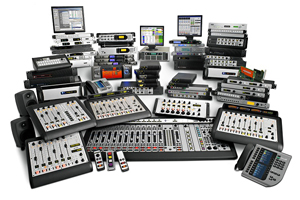Telos Alliance Leads the Way on AES67 | Telos Alliance
By The Telos Alliance Team on Jan 15, 2015 9:43:00 AM
 Telos Alliance Leads the Way on AES67
Telos Alliance Leads the Way on AES67
When the Audio Engineering Society published the AES67 standard for Audio over IP in September 2013, it symbolized the culmination of years of development work by people across the broadcast industry. But for Telos, it symbolized not just an industry standard, but the realization of the vision of our founder, Steve Church. As such, we were proud to have been involved since the project’s inception, and have seen it through to fruition.
The background story of AES67 – formerly known as x.192 – is a long one. As Telos Alliance Chief Science Officer Greg Shay explains it, it all began in the early 2000s. At the time, the best network technology available had just been incorporated into Livewire, the audio over Ethernet system developed by Axia Audio in 2003. From there, says Shay, “The natural step forward was an industry standard to allow interoperability across various IP-based audio networking systems.”
To be sure, multiple entities have been involved in the process over the years, including ALCNetworx (inventors of the RAVENNA protocol), and QSC. But the drive to develop an interoperability standard was due in no small part to a connection Telos made with Kevin Gross, developer of CobraNet, a collection of software, hardware, and network protocols designed to deliver low-latency, uncompressed digital audio over Ethernet. Gross saw an interest in developing an AoIP standard, and presented the idea to the AES, with Telos supporting the project through research and financial contributions.
Telos’ involvement in the project came naturally. As a proponent of interoperability for years, there wasn’t a second thought. Instead, it was second nature. What it wasn’t, was smooth sailing. The AES committee charged with formulating the standard had to come to a consensus regarding a specific, essential subset of abilities for the first step forward, or else face the possibility of failure due to biting off more than they could chew. In the end, the committee drew up an appropriate standard, and the work paid off.
specific, essential subset of abilities for the first step forward, or else face the possibility of failure due to biting off more than they could chew. In the end, the committee drew up an appropriate standard, and the work paid off.
As Shay points out, “The timing was right for it. Other technology had traction but reached its limits, due to being vendor-specific. It was time to go to the next level.” That next level needed to be more than just a document supporting the concept of interoperability; it had to go much deeper to have any effect in the industry. As Telos’ Marty Sacks puts it, “It’s about developing an AoIP ecosystem.” With AES67, this model is fully realized.
The standard has been accepted industry-wide, becoming the topic of nearly every conversation where two or more engineers are gathered; all major radio broadcast entities have embraced it. The success of the first inaugural AES67 Interoperability PlugFest, held recently in Munich, is evidence of this. Shay says that several broadcast entities participated, and almost everything worked off the bat.
The key to the success of AoIP and AES67 within the broadcast audio industry is the intentional leveraging of the billions of dollars of R&D previously invested by the IT industry — making the invention of new technology unnecessary. “We’ve hitched our wagon to that massive engine of computers and networks,” says Shay. After all, why re-invent the wheel
What does the future hold? Certainly there is more work to be done; the current iteration of the standard is merely the first. Not all desired capabilities are supported yet. Plans are in place to incorporate more functionality, and Shay believes the standard will make an impact not only within broadcast, but in other audio-related industries as well.
Steve Church’s dream of AoIP interoperability lives! And The Telos Alliance intends to be firmly at the vanguard, helping to realize that dream in ways that benefit broadcasters everywhere.
Telos Alliance has led the audio industry’s innovation in Broadcast Audio, Digital Mixing & Mastering, Audio Processors & Compression, Broadcast Mixing Consoles, Audio Interfaces, AoIP & VoIP for over three decades. The Telos Alliance family of products include Telos® Systems, Omnia® Audio, Axia® Audio, Linear Acoustic®, 25-Seven® Systems, Minnetonka™ Audio and Jünger Audio. Covering all ranges of Audio Applications for Radio & Television from Telos Infinity IP Intercom Systems, Jünger Audio AIXpressor Audio Processor, Omnia 11 Radio Processors, Axia Networked Quasar Broadcast Mixing Consoles and Linear Acoustic AMS Audio Quality Loudness Monitoring and 25-Seven TVC-15 Watermark Analyzer & Monitor. Telos Alliance offers audio solutions for any and every Radio, Television, Live Events, Podcast & Live Streaming Studio With Telos Alliance “Broadcast Without Limits.”
Recent Posts
Subscribe
If you love broadcast audio, you'll love Telos Alliance's newsletter. Get it delivered to your inbox by subscribing below!